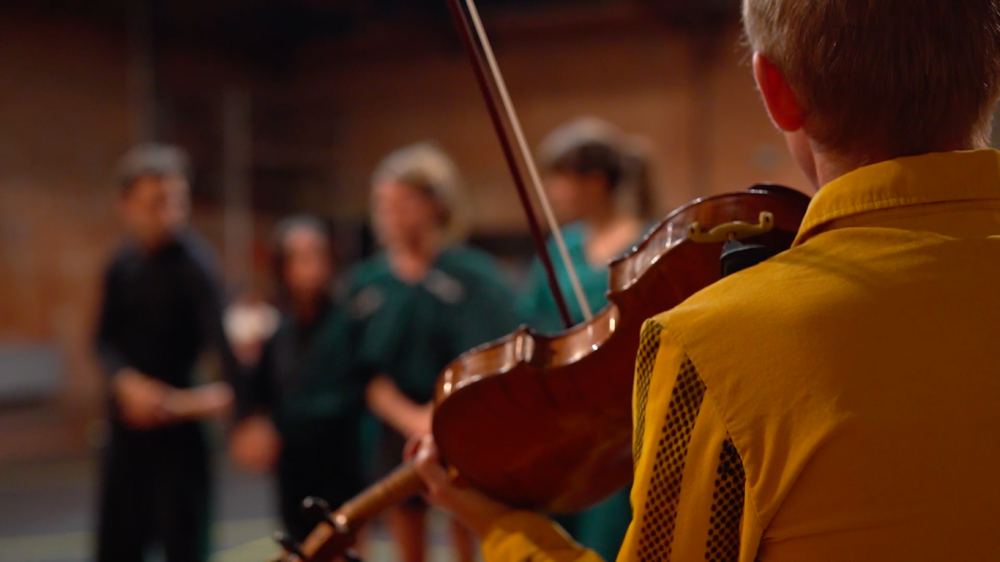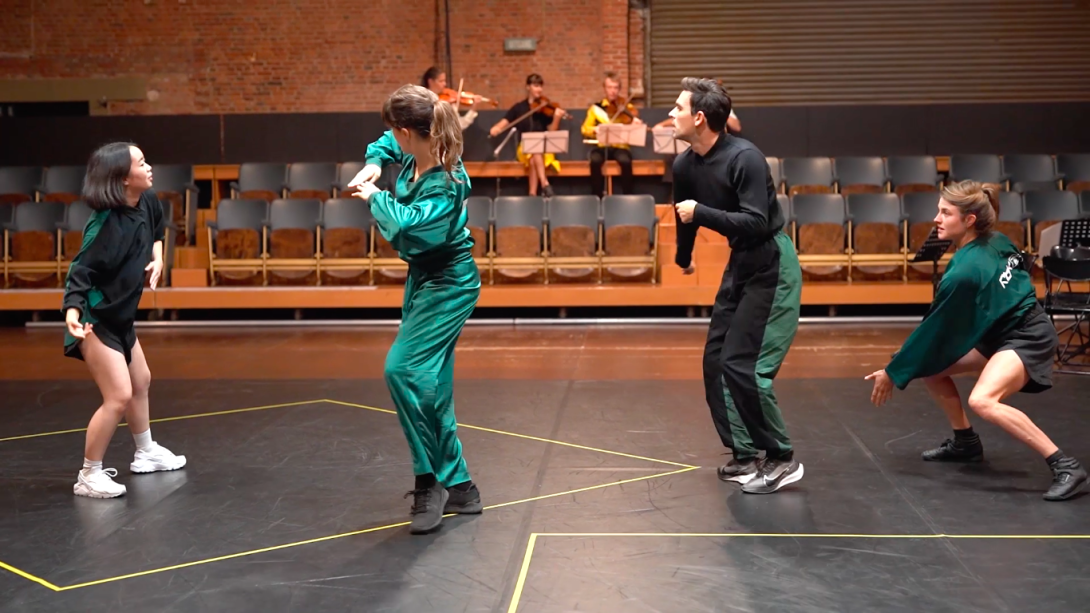Tactile Quartet(s): interview excerpts
In an interview by JS Rafaeli, the members of Tactile Quartet(s) share some thoughts and reflections. Speaking are choreographer Vera Tussing, musical collaborator Michael Picknett, dancers Esse Vanderbruggen, Vera Tussing, Yoh Morishita, Zoltán Vakulya, the Quatuor MP4 (Claire Bourdet, Margaret Hermant, Pierre Heneaux, Merryl Havard) and the costume and set designer Jivan van der Ende.
Where do you find pleasure in this work? Where do you find friction?
Vera: For the dancers, the proximity of their quartet creates a certain tension, it allows their bodies to overlap, to invite a game between hitting and caressing. There are pleasurable synchronicities in terms of visual and tactile perception, especially in how members of the audience are brought into that dynamic. There are also tensions in being trying to hold multiple types of performative bodies in one – interestingly in this piece, this is as true for the musicians as for the dancers.
Michael: I love the idea of recognition within a work. Using fragments and repetition is a good way of engendering this. I love hearing something for the first time and finding it familiar. I love this idea from Helmut Lachenmann that all music is built from dissonance and harmony. In one’s artistic practice you have to find what is ‘dissonance’ for you and what is your ‘harmony’. I suppose dissonance is a tension and harmony is the release, but this could take on many forms – Lachenmann’s own composition is a good example of this. In my own work dissonance takes the form of a performer striking out on its own, creating material out of kilter with the others. I love these moments of tension and seeing how they get resolved.
Claire (MP4): I love being connected with the dancers in terms of energy. As a musician, you are often ‘hidden’ behind your instrument. So, this is very much a journey outside the comfort zone.
Yoh: The embodiment of music and the connection with the musicians and the audience is very pleasurable, but music can be so dominant that it is difficult to find independence dancing. It is a paradox that the pleasure and the friction come from the same source in the piece.
Esse: I look for the moment that the self can merge into the us – I call it the ‘soup effect’. There is pleasure in being together, in needing the other elements for yours to have meaning, and being needed by the others in return. Then there is friction in the moment of breaking, in switching to other modes of performativity – that moment I realise that my personal trajectory is not necessarily the dramaturgical trajectory of the piece!
Zoltan: The combination of listening and moving within the four of us is very pleasurable – as is the feeling of performing while surrounded on three sides by audience. I am enjoying how the embodiment of the music deepens as the piece approaches the premiere. Of course, there are always bits of friction in achieving that relationship with music.
Has the process made you think in any new ways about how sound relates to tactility?
Michael: In this particular process, the main tactility I focused on was a particular attention to how the string players’ fingers interact with the instrument. This comes from the ‘tactile quartets task’ that Vera originally proposed. This is not something I have thought about within my own work. In the past, I have been interested in the sound generated, the presence of the performer – and how they interact. For example, I have an interest in games between musicians as a way of generating material. I love the idea of hearing something like chess – what was the move this player made? What will the other player do now?
I looked at the types of touch the audience will experience in the ‘tactile quartets section’: Left Hand harmonics (very soft and gentle), Right Hand forte bowing (heavy pressure from the bow), Left Hand pizzicato (a gentle scratching across the arm), Right Hand Bartok pizzicato (a heavy pulling up from the arm) – and many more. All these tactile interactions have specific sounds I wanted to introduce through the material, so I created tasks that brought out these qualities.
The other sense of tactility I was interested in came from the tactility of the sound on the skin – the presence of the musician. This is something that I have explored in my practice. There is something about being close to a performing musician that brings out the tactility of their playing – the mechanics of making the sound. It emphasises the existence of the individual within the group. In a conventional music presentation, the sound is blended to be perceived the same everywhere in the auditorium, but in Tactile Quartet(s), proximity to certain instruments within the scenography of the piece creates a completely unique sonic/tactile experience for each individual audience member!
This is particularly interesting within a chamber music context, as each musician has a separate role within the music – contrasted to the orchestra, for example, where there might be twenty violins playing the same notes.
How is playing in a quartet different to other musical constellations in which you have participated?
Quatuor MP4: The quartet is an ongoing engagement, meaning that you can't escape. You have to find your way in doing things together, and find a clear identity as a group, more than in any other constellations.
How has your relationship with this constellation shifted, changed or grown over the 10 years of MP4?
Quatuor MP4: There were challenging musical events that made us grow as a group, each of them a good step in learning more about each of our own will, capacity and human resources. Even if we are quite different and not always sharing everything, we deeply respect and trust each other. It is a kind of special friendship.
How did you find Michael’s process? In what ways were his methods of guiding you through tasks different (or similar) to other processes you have worked on?
Quatuor MP4: During the improvisation process, Michael really helped us to decide, choose and avoid friction between the four of us. This can very easily turn into 'the one who's more talkative takes the ascendant role over the others’. Michael definitely led us away from those dynamics.
How does a sense of costume and design reflect notions of collectivity, groups, communities,quartets?
Jivan: The relation between garment and body has been a long running topic in discussions between Vera and I. We spoke about the relationship between gender and clothing, how garments influence our way of looking at the wearer – even in subtle details – with a focus on the active body, the moving body, the working body, the directing body, the gendered body, and how these bodies can be dressed in an empowered way.
We wanted to break with the images that aestheticize the body, and erases with a ‘romantic’ beauty the action/image of the work. This led us towards unisex uniforms, sportswear and casual wear. I searched how to grasp the connotations that are linked to these garments, dissecting them in detail so we could create silhouettes for the active, empowered, individual performers.
We considered many different aspects: the performers’ individual personalities, their choreographed movements, their personal position in the group, and position in the scenography – as well as the fabric’s tactile impression, its ability to form distinct formations, and how its tactility relates to both the performer’s and audience’s experience.
What process(es) of embodiment characterised the creation for you? Did they make you reflect on ideas of harmony and dissonance?
Esse: When one understands the core of a choreographic task, it can give the freedom to lead and discover for oneself. A state of harmony can make me rise away from the individual and experience a bigger picture. This is something I really look for in this piece – the moment that things that I wouldn't be able to name merge and create something new. I feel it important to figure out a little dramaturgy of performativity and embodiment within myself – something that overflows 'sections', in order to float between harmony and dissonance as a choice-based experience.
Zoltan: I feel very self-led in this process. This is a short creation and I think we are still yet to ‘know’ the material. I look forward to seeing how it becomes clear through performing. I use different sources of inspiration – I have a personal history of movement and music that informs me, as well as the choreographic instruction. I am inspired by being with the sound in the moment – music can dance, but I don’t think I can be music.
Yoh: There is a evolution in the piece, from moving in a square on stage – a very limited space – into moving in lines, and further into space. The combination of lines and boxes almost makes me think of a musical notation score – which might be appropriate!
There is I think a progress of harmonisation between the individual and the group, within the performers – and the audience is included too by the end. I feel a bit emotional about it. I feel my role in the quartet is one of continuity – if we are Queen, then I am John Deacon rather than Freddy Mercury. I think maybe Esse is Freddy Mercury – or Esse is the sun and I am the moon. On the other hand, I do take leadership roles at points in the piece – for instance at the very start, and during our ‘hocket’ section.

